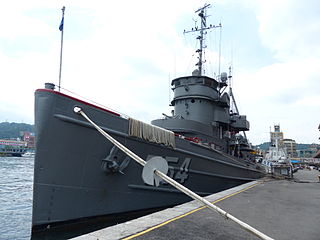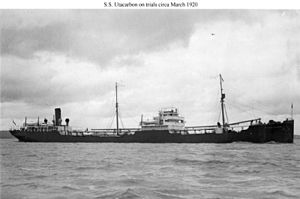
USS Achomawi (AT-148/ATF-148) was an Abnaki-class fleet ocean tug in the service of the United States Navy, and was named for the Achomawi tribe of Native Americans.

USS Hoe (SS-258), a Gato-class submarine, was a ship of the United States Navy named for the hoe, one of various sharks, especially the dogfish.

USS Brill (SS-330), a Balao-class submarine, was a ship of the United States Navy in commission from 1944 to 1947. She was named for the brill, a European flatfish.

USS Bumper (SS-333), a Balao-class submarine, was a ship of the United States Navy named for the bumper, a small fish of the North and South Atlantic Ocean.

USS Alameda, was a United States Navy tanker in commission from 1919 to 1922. She was built as the civilian tanker SS Alameda, but transferred to the U.S. Navy after completion in 1919. She was sold for commercial service and operated under the names SS Olean and SS Sweep before she was transferred to the Navy again in World War II as USS Silver Cloud (IX-143).

USS Zebra (AKN-5) was an Indus-class net cargo ship in the service of the United States Navy in World War II. The ship was originally the Matthew Lyon, an EC2-S-C1 Liberty ship, operated for the War Shipping Administration (WSA) as a cargo vessel by an agent until severely damaged by torpedo in August 1943. While at Espiritu Santo in the New Hebrides awaiting likely scrapping the Navy acquired the vessel under bareboat charter to be used as a net cargo ship transporting reclaimed anti-submarine netting.

USS Wheatland (AKA-85) was a Tolland-class attack cargo ship in service with the United States Navy from 1945 to 1946. She was sold into commercial service and was scrapped in 1973.
USS Armadillo (IX-111), the lead ship of her class of tanker was the only ship of the United States Navy to be named for the armadillo, an insect-eating mammal which has an armorlike shell encasing its back and head.

USS Gardoqui (IX-218), an unclassified miscellaneous vessel, was the only ship of the United States Navy to be named for USS Gardoqui, a Spanish gunboat captured during the Spanish–American War. Her name was misspelled when she was christened. Gardoqui was named for the commercial house of Joseph Gardoqui and Sons of Bilbao, Spain, which represented the American Colonies in the Spanish court during the American Revolution. Her keel was laid down in 1921 by the Federal Shipbuilding Company, in Kearny, New Jersey. She was acquired from the War Shipping Administration and commissioned at Pearl Harbor on 23 June 1945 with Lieutenant Harold L. Tysinger in command.
The second USS Whippet (IX-129), an Armadillo-class tanker designated an unclassified miscellaneous vessel, was the second ship of the United States Navy to be named for the whippet. Her keel was laid down on 31 October 1943 at New Orleans, Louisiana, by the Delta Shipbuilding Company under a Maritime Commission contract. She was launched on 15 December 1943 sponsored by Mrs. Will Camp Sealy, delivered to the Navy on 13 January 1944, and commissioned on 14 January 1944.

USS Braxton (APA-138) was a Haskell-class attack transport in service with the United States Navy from 1944 to 1946. She was scrapped in 1973.
USS Yahara (AOG-37) was a Mettawee-class gasoline tanker acquired by the U.S. Navy for the dangerous task of transporting gasoline to warships in the fleet, and to remote Navy stations.

USS Anacostia (AO-94) was a Escambia-class replenishment oiler acquired by the United States Navy for use during World War II. She had the dangerous but necessary task of providing fuel to vessels in combat and non-combat areas. She served in the Pacific Ocean Theater of operations late in the war, and returned home with one battle star.

USS Enoree (AO-69) was a Chiwawa-class oiler constructed for the United States Navy during World War II. She was the only U.S. Navy ship named for the Enoree River in South Carolina.
USS Alderamin (AK-116) was a Crater-class cargo ship commissioned by the U.S. Navy for service in World War II, named after Alderamin, the alpha star in constellation Cepheus. She was responsible for delivering troops, goods and equipment to locations in the war zone.
USS Syrma (AK-134) was a Crater-class cargo ship commissioned by the U.S. Navy for service in World War II. She was responsible for delivering troops, goods and equipment to locations in the war zone.
USS Tularosa (AOG-43) was a Mettawee-class gasoline tanker acquired by the U.S. Navy for the dangerous task of transporting gasoline to warships in the fleet, and to remote Navy stations.
The USS Arayat (IX-134) was a petroleum tanker built in 1918 at Glasgow, Scotland, by Fairfield Shipbuilding, as SS Faireno. She was acquired by the United States Navy from the War Shipping Administration on 13 April 1944 at Brisbane, Australia, and commissioned there on 18 April 1944.

The second USS Marmora (IX-189) was a United States Navy tanker in commission from 1944 to 1946. She saw service as a mobile floating storage ship during and in the immediate aftermath of World War II.
USS Sea Foam (IX-210) was a Mobile Floating Storage Tanker of the United States Navy in the closing stages of World War II. Sea Foam was built as the SS Pennsylvania—an Emergency Fleet Corporation Design 1045 tanker in Quincy, Massachusetts, in 1917 for World War I civilian merchant service.












